Unit 1 Asia Comic strip & Welcome to the unit 课件(共28张PPT) 牛津译林版九年级英语下册
文档属性
| 名称 | Unit 1 Asia Comic strip & Welcome to the unit 课件(共28张PPT) 牛津译林版九年级英语下册 |  | |
| 格式 | pptx | ||
| 文件大小 | 4.9MB | ||
| 资源类型 | 教案 | ||
| 版本资源 | 牛津译林版 | ||
| 科目 | 英语 | ||
| 更新时间 | 2025-01-25 13:49:56 | ||
图片预览

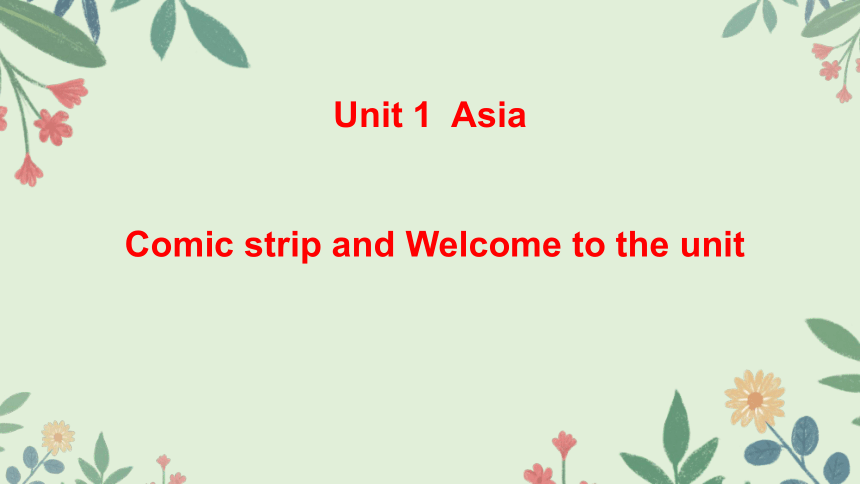
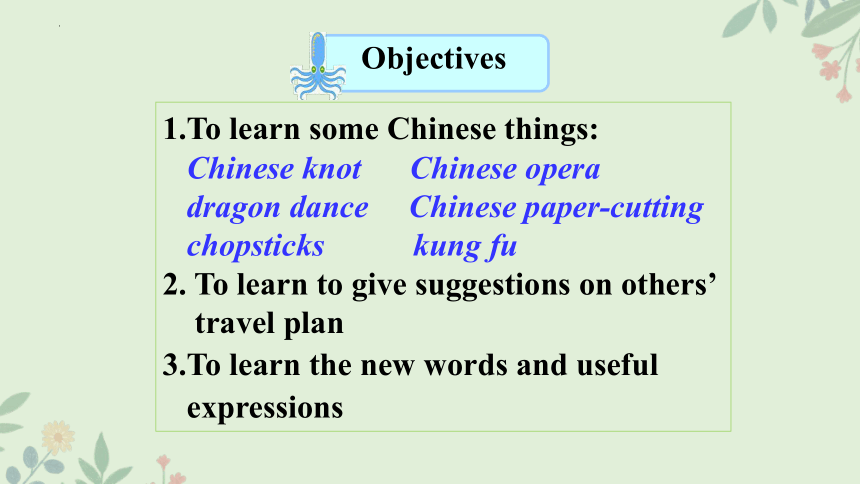
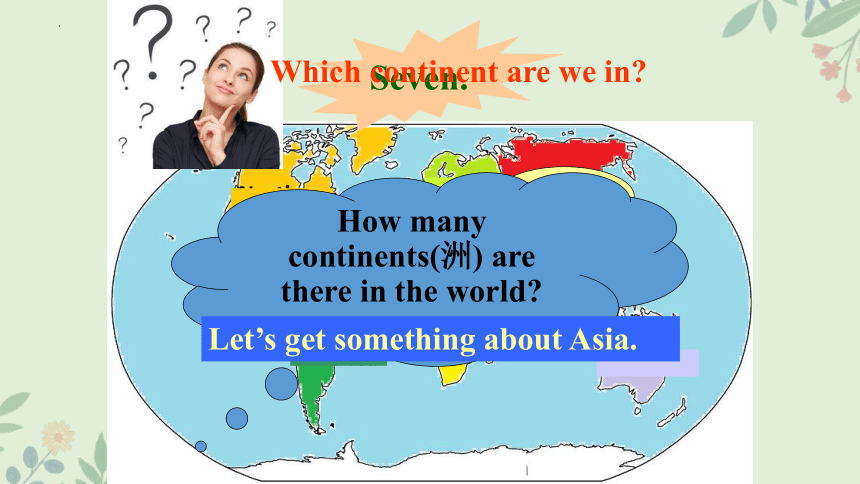

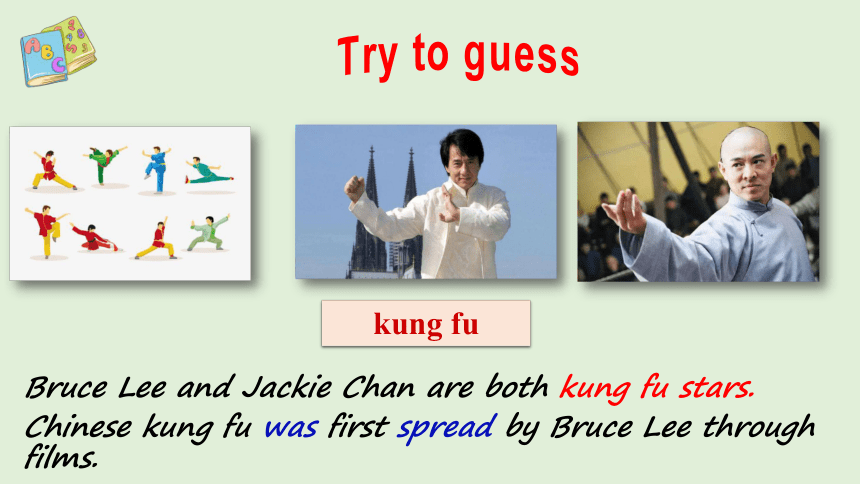
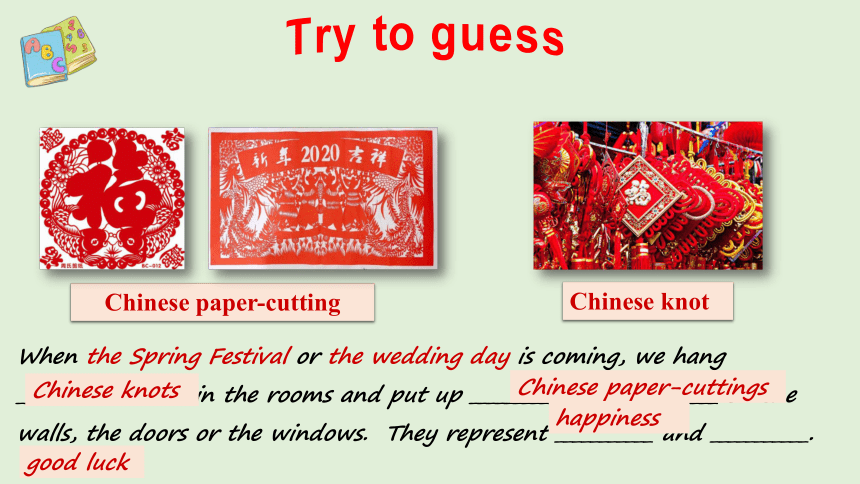
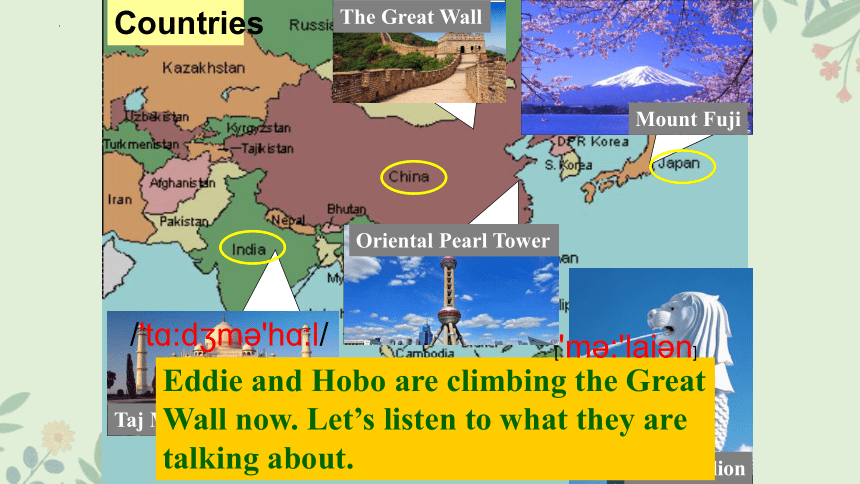
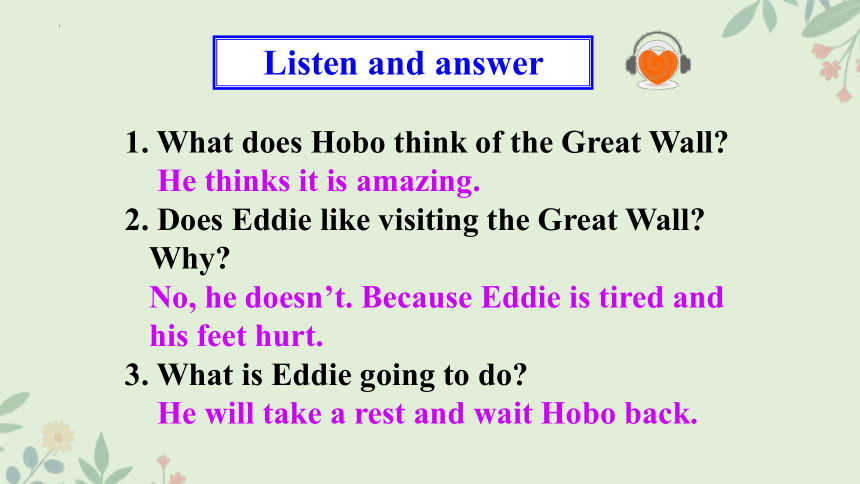
文档简介
(共28张PPT)
牛津译林版九年级英语下册
Unit1 Asia Comic strip & Welcome to the unit
Unit 1 Asia
Comic strip and Welcome to the unit
To learn some Chinese things:
Chinese knot Chinese opera
dragon dance Chinese paper-cutting
chopsticks kung fu
2. To learn to give suggestions on others’
travel plan
3.To learn the new words and useful expressions
Objectives
Seven.
Asia
How many continents(洲) are there in the world
Which continent are we in
Let’s get something about Asia.
Geography: the largest continent
Land area: 30% of the world’s total land area
some of the oldest human civilizations were in Asia
Population: More than 4.1 billion
Try to guess
kung fu
Bruce Lee and Jackie Chan are both kung fu stars.
Chinese kung fu was first spread by Bruce Lee through films.
Try to guess
Chinese paper-cutting
Chinese knot
When the Spring Festival or the wedding day is coming, we hang ___________________ in the rooms and put up ____________________________ on the walls, the doors or the windows. They represent ___________ and ___________.
Chinese knots
Chinese paper-cuttings
happiness
good luck
Countries
The Great Wall
Oriental Pearl Tower
Mount Fuji
Taj Mahal
The Merlion
Eddie and Hobo are climbing the Great Wall now. Let’s listen to what they are talking about.
/'tɑ:d m 'hɑ:l/
['m :'lai n]
Listen and answer
1. What does Hobo think of the Great Wall
He thinks it is amazing.
2. Does Eddie like visiting the Great Wall Why
No, he doesn’t. Because Eddie is tired and his feet hurt.
3. What is Eddie going to do
He will take a rest and wait Hobo back.
Try to guess
dragon dance
What is dragon dance used for
Dragon dance is a kind of traditional __________ .
It is usually used for the celebrations of ______________________and ____________________________.
Chinese art
the Spring Festival
the opening of new stores
Try to guess
It is believed that chopsticks have been around for about 5,000 years and that they were first used in China.
a pair of chopsticks
Act it out
1. Use different tones (语气).
2. Add your own actions to make the dialogue more interesting.
Part A
dragon dance
Chinese opera
chopsticks
Chinese knot
Chinese paper-cutting
kung fu
Help Millie write the correct name of Chinese things under each picture.
Words
raising升高
raise
flag旗帜
There is a red flag over there.
Can you see those flags
Weicome to the unit
Wow,the Grat Wall is amazing ,isn’t it
哇,长城太神奇了,不是吗
isn’t it反意疑问句
the Great Wall
长城
Chinese things and places
silk
dragon dance
Chinese things and places
Chinese paper-cutting
Chinese knot
Weicome to the unit
No,it isn’t.
不,它不是。
It’s tiring to climb the steps,and my feet hurt.
I’m taking a rest.
爬台阶很累,我的脚也疼。
我正在休息。
it is +adj +to do sth
Weicome to the unit
take a rest 休息一下
No,Eddie!
不,艾迪。
There is still a long way to go.
还有很长的路要走。
There’s =There is
Chinese things and places
the Great Wall
Tian’anmen square
Listen and answer the questions.
1.What does Hobo think of the Great Wall
2.Does Eddie like visiting the Great Wall Why
3.Do you think Eddie will continue to the end
He thinks it’s amazing.
No, he doesn’t. He thinks that it’s tiring to climb the step and his feet hurt.
No, I don’t think so.
Weicome to the unit
We'd better keep moving .
我们最好继续前进。
had better do sth
做好做某事
had better not do sth
最好不要做某事
Read and act out the dialogue.
Fill in the blank
One day, Hobo and Eddie ________ the Great Wall. Hobo thought it was ________ to climb the Great Wall, but Eddie felt very ______. Hobo encouraged Eddie to keep _______, but Eddie decided to _______ a rest.
climbed
amazing
tired
moving
take
Wow, the Great Wall is amazing, isn’t it
哇,长城真壮观啊,不是吗?
本句是反意疑问句,用来征求对方的看法。
这种疑问句有两部分组成,前一部分是陈述句,后一部分是附加问句,中间用逗号隔开。附加问句一般由“be动词/ 助动词/ 情态动词+代词”构成。两部分的人称、时态应保持一致。
两种形式:
a. 前肯后否 :He likes cats, doesn’t he
b. 前否后肯:This isn’t your book, is it
Language point
答语:
反意疑问句也用yes或no作答,事实是肯定的就用yes,
事实是否定的就用no.
1. —He is your teacher, isn’t he 他是你的老师,不是吗?
—Yes, he is.是的,他是。/ No, he isn’t. 不,他不是。
2. —Liming can’t swim , can he 李明不会游泳,是吗?
—Yes, he can.不,他会。/ No, he can’t.是的,他不会。
陈述部分为祈使句:
陈述部分若是Let’s开头的祈使句,其附加问句为shall we; 不是以Let’s开头的祈使句,附加问句都可用won’t you。
Let's meet at the airport, shall we
咱们在机场见,可以吗?
Close the windows before leaving, will you
离开前请关上窗,可以吗?
Thank you!
牛津译林版九年级英语下册
Unit1 Asia Comic strip & Welcome to the unit
Unit 1 Asia
Comic strip and Welcome to the unit
To learn some Chinese things:
Chinese knot Chinese opera
dragon dance Chinese paper-cutting
chopsticks kung fu
2. To learn to give suggestions on others’
travel plan
3.To learn the new words and useful expressions
Objectives
Seven.
Asia
How many continents(洲) are there in the world
Which continent are we in
Let’s get something about Asia.
Geography: the largest continent
Land area: 30% of the world’s total land area
some of the oldest human civilizations were in Asia
Population: More than 4.1 billion
Try to guess
kung fu
Bruce Lee and Jackie Chan are both kung fu stars.
Chinese kung fu was first spread by Bruce Lee through films.
Try to guess
Chinese paper-cutting
Chinese knot
When the Spring Festival or the wedding day is coming, we hang ___________________ in the rooms and put up ____________________________ on the walls, the doors or the windows. They represent ___________ and ___________.
Chinese knots
Chinese paper-cuttings
happiness
good luck
Countries
The Great Wall
Oriental Pearl Tower
Mount Fuji
Taj Mahal
The Merlion
Eddie and Hobo are climbing the Great Wall now. Let’s listen to what they are talking about.
/'tɑ:d m 'hɑ:l/
['m :'lai n]
Listen and answer
1. What does Hobo think of the Great Wall
He thinks it is amazing.
2. Does Eddie like visiting the Great Wall Why
No, he doesn’t. Because Eddie is tired and his feet hurt.
3. What is Eddie going to do
He will take a rest and wait Hobo back.
Try to guess
dragon dance
What is dragon dance used for
Dragon dance is a kind of traditional __________ .
It is usually used for the celebrations of ______________________and ____________________________.
Chinese art
the Spring Festival
the opening of new stores
Try to guess
It is believed that chopsticks have been around for about 5,000 years and that they were first used in China.
a pair of chopsticks
Act it out
1. Use different tones (语气).
2. Add your own actions to make the dialogue more interesting.
Part A
dragon dance
Chinese opera
chopsticks
Chinese knot
Chinese paper-cutting
kung fu
Help Millie write the correct name of Chinese things under each picture.
Words
raising升高
raise
flag旗帜
There is a red flag over there.
Can you see those flags
Weicome to the unit
Wow,the Grat Wall is amazing ,isn’t it
哇,长城太神奇了,不是吗
isn’t it反意疑问句
the Great Wall
长城
Chinese things and places
silk
dragon dance
Chinese things and places
Chinese paper-cutting
Chinese knot
Weicome to the unit
No,it isn’t.
不,它不是。
It’s tiring to climb the steps,and my feet hurt.
I’m taking a rest.
爬台阶很累,我的脚也疼。
我正在休息。
it is +adj +to do sth
Weicome to the unit
take a rest 休息一下
No,Eddie!
不,艾迪。
There is still a long way to go.
还有很长的路要走。
There’s =There is
Chinese things and places
the Great Wall
Tian’anmen square
Listen and answer the questions.
1.What does Hobo think of the Great Wall
2.Does Eddie like visiting the Great Wall Why
3.Do you think Eddie will continue to the end
He thinks it’s amazing.
No, he doesn’t. He thinks that it’s tiring to climb the step and his feet hurt.
No, I don’t think so.
Weicome to the unit
We'd better keep moving .
我们最好继续前进。
had better do sth
做好做某事
had better not do sth
最好不要做某事
Read and act out the dialogue.
Fill in the blank
One day, Hobo and Eddie ________ the Great Wall. Hobo thought it was ________ to climb the Great Wall, but Eddie felt very ______. Hobo encouraged Eddie to keep _______, but Eddie decided to _______ a rest.
climbed
amazing
tired
moving
take
Wow, the Great Wall is amazing, isn’t it
哇,长城真壮观啊,不是吗?
本句是反意疑问句,用来征求对方的看法。
这种疑问句有两部分组成,前一部分是陈述句,后一部分是附加问句,中间用逗号隔开。附加问句一般由“be动词/ 助动词/ 情态动词+代词”构成。两部分的人称、时态应保持一致。
两种形式:
a. 前肯后否 :He likes cats, doesn’t he
b. 前否后肯:This isn’t your book, is it
Language point
答语:
反意疑问句也用yes或no作答,事实是肯定的就用yes,
事实是否定的就用no.
1. —He is your teacher, isn’t he 他是你的老师,不是吗?
—Yes, he is.是的,他是。/ No, he isn’t. 不,他不是。
2. —Liming can’t swim , can he 李明不会游泳,是吗?
—Yes, he can.不,他会。/ No, he can’t.是的,他不会。
陈述部分为祈使句:
陈述部分若是Let’s开头的祈使句,其附加问句为shall we; 不是以Let’s开头的祈使句,附加问句都可用won’t you。
Let's meet at the airport, shall we
咱们在机场见,可以吗?
Close the windows before leaving, will you
离开前请关上窗,可以吗?
Thank you!
